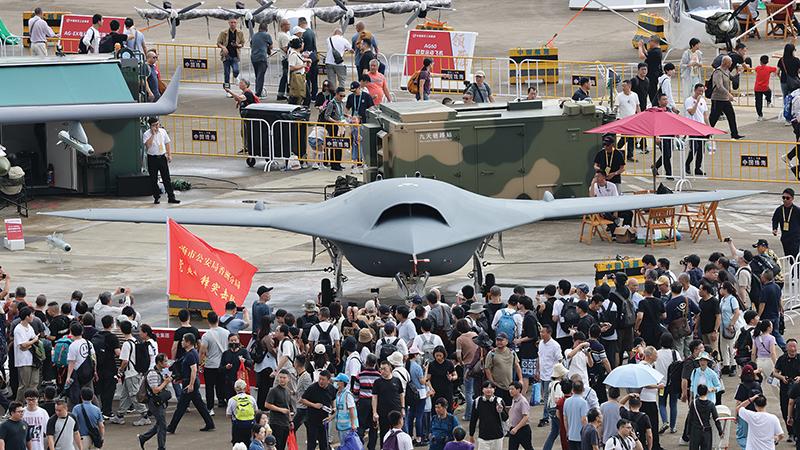Commentary: Zhuhai Reveals Evolution Of Chinese Military Aircraft
Details
More Products & Services
Products & Services
Aerospace | Aviation Week Network
Aviation Week Network
https://aviationweek.com/themes/custom/particle/dist/app-drupal/assets/awn-logo.svg
Home - Aviation Group Marketing
Aviation Week Network
120 data points on over 156,000 commercial and business aviation aircraft, including military transports. Discover the most trustworthy resource for the complete aircraft history, plus ad hoc reports, month-over-month trend analysis and details on expected deliveries through 2050.
People

Andrea Rossi Prudente
Aviation Week Network

Becca Balmes
Aviation Week Network

Belinda Tan
Aviation Week Network

Brian Everstine
Aviation Week Network
Editor

Eddie Krankowski
Aviation Week Network
Assistant Manager, Tradeshows

erving dockery
Aviation Week Network

Lisa Tan
Aviation Week Network
Senior Marketing Manager

Mark Thomas
Aviation Week Network
Description
Bands of heavy rain and a layer of smog hung over the 600,000 visitors to Zhuhai International Airport in mid-November for the China International Aviation & Aerospace Exhibition. But soaking, murky weather could not obscure another stunning display of progress by China's aerospace industry.
Held biennially on the southeastern coast, a short ferry ride from Hong Kong, the four-day event—also known as the Zhuhai Airshow—stopped short of revealing all of China's aerospace secrets, including the still-unreleased shape and status of the Xian H-20 stealth bomber.
Even so, the show served as the public, international debut of China's second operational stealth fighter as well as a showcase for a diversifying portfolio of uncrewed combat air vehicles (UCAV) and a stage for ambitions in aerospace technology development. The J-35, China's newest locally designed stealth fighter, made its flying display debut. Credit: Hector Retamal/AFP via Getty Images
Several of the star attractions appeared familiar. To wit: The Chinese Navy's Shenyang J-35A carrier-based stealth fighter appeared at Zhuhai for the first time, but its FC-31 prototype made its debut in the flying display a decade earlier. A mockup of the six-year-old CH-7 concept appeared alongside video of the prototype's first flight. Credit: Marina Lystseva An early mockup of the China Aerospace Science and Technology Corp. CH-7 UCAV debuted at Zhuhai in 2018, but a redesigned model arrived this year alongside a state-sponsored documentary film revealing the formerly secret prototype's first flight.The mysterious Cloud Shadow CS-5000T was on full display this year, but the stealthy UCAV with an ample internal weapons bay appeared first in 2022, albeit with its aft fuselage shrouded from view.
The Cloud Shadow example offers a rare glimpse into China's protean process for revealing semi-secret aerospace technology.
The first clue of the CS-5000T's existence came at the 2018 Zhuhai Airshow. A subscale prototype of an identical design appeared in the Avic section of the static display—but lacked identification. Hours later, the model vanished without explanation.
The full-scale, Chengdu-made prototype subsequently appeared at Zhuhai four years later, albeit with the tail obscured. Video of the identical-looking aircraft in flight appeared online last year but with no official acknowledgment or explanation. An exhibit hall attraction revealed a concept for a hypersonic glide vehicle capable of dispensing drones and munitions. Credit: Marina Lystseva
The Chinese Air Force already operates the Hongdu GJ-11 Sharp Sword, a UCAV with similar stealthy features and dimensions. Why, however, would the Chinese Air Force simultaneously fund Hongdu's UCAV and Chengdu's CS-5000T, both stealthy designs seemingly in the 5-ton weight class?
Perhaps the answer can be found closer to home. The U.S. Air Force also is developing prototypes of stealthy, 5-ton UCAVs under the Collaborative Combat Aircraft (CCA) program. The Air Force-funded aircraft—the General Atomics Aeronautical Systems Inc. Gambit and Anduril Industries Fury—are not stealthy, flying-wing aircraft, but the rejected proposals for the CCA Increment 1 contract from Boeing, Lockheed Martin and Northrop Grumman likely were. There is precedent for funding competing prototypes of stealthy UCAVs. China may be simultaneously developing advanced UCAVs and low-cost options, such as the FH-97A. Credit: Marina Lystseva
Not that China appears to be limiting its options to only two UCAVs to fly alongside the J-35 and Chengdu J-20 on future combat missions. The static display at Zhuhai also featured the Feihong FH-97A, another UCAV unveiled at the 2022 air show. Unlike the flying-wing GJ-11 and CS-5000T, the design of the FH-97 resembles other low-cost, attritable concepts, including the Kratos XQ-58 Valkyrie and Boeing Australia MQ-28 Ghost Bat. Once a main attraction, stealthy J-20s (pictured) are being overshadowed by a diverse group of UCAVs. Credit: Marina Lystseva
Air show displays are sometimes unreliable indicators of future Chinese military inventory plans, though. In 2022, for example, the Zhuhai exhibit hall featured a mockup of the MD-22, a reputedly Mach 7 demonstrator to be air-launched by a Xian H-6 bomber. Although the exhibit hall mockup dominated headlines for the Zhuhai Airshow, the MD-22 has never been seen again. It may yet resurface at a future event, as the CS-5000T reemerged after its fleeting 2018 debut in subscale form. Or it may be canceled, if indeed it was a serious project to begin with. The Air White Whale W5000, a large, autonomous cargo delivery aircraft, is scheduled to enter service before 2027. Credit: Marina Lystseva
Held biennially on the southeastern coast, a short ferry ride from Hong Kong, the four-day event—also known as the Zhuhai Airshow—stopped short of revealing all of China's aerospace secrets, including the still-unreleased shape and status of the Xian H-20 stealth bomber.
Even so, the show served as the public, international debut of China's second operational stealth fighter as well as a showcase for a diversifying portfolio of uncrewed combat air vehicles (UCAV) and a stage for ambitions in aerospace technology development. The J-35, China's newest locally designed stealth fighter, made its flying display debut. Credit: Hector Retamal/AFP via Getty Images
Several of the star attractions appeared familiar. To wit: The Chinese Navy's Shenyang J-35A carrier-based stealth fighter appeared at Zhuhai for the first time, but its FC-31 prototype made its debut in the flying display a decade earlier. A mockup of the six-year-old CH-7 concept appeared alongside video of the prototype's first flight. Credit: Marina Lystseva An early mockup of the China Aerospace Science and Technology Corp. CH-7 UCAV debuted at Zhuhai in 2018, but a redesigned model arrived this year alongside a state-sponsored documentary film revealing the formerly secret prototype's first flight.The mysterious Cloud Shadow CS-5000T was on full display this year, but the stealthy UCAV with an ample internal weapons bay appeared first in 2022, albeit with its aft fuselage shrouded from view.
The Cloud Shadow example offers a rare glimpse into China's protean process for revealing semi-secret aerospace technology.
The first clue of the CS-5000T's existence came at the 2018 Zhuhai Airshow. A subscale prototype of an identical design appeared in the Avic section of the static display—but lacked identification. Hours later, the model vanished without explanation.
The full-scale, Chengdu-made prototype subsequently appeared at Zhuhai four years later, albeit with the tail obscured. Video of the identical-looking aircraft in flight appeared online last year but with no official acknowledgment or explanation. An exhibit hall attraction revealed a concept for a hypersonic glide vehicle capable of dispensing drones and munitions. Credit: Marina Lystseva
The Chinese Air Force already operates the Hongdu GJ-11 Sharp Sword, a UCAV with similar stealthy features and dimensions. Why, however, would the Chinese Air Force simultaneously fund Hongdu's UCAV and Chengdu's CS-5000T, both stealthy designs seemingly in the 5-ton weight class?
Perhaps the answer can be found closer to home. The U.S. Air Force also is developing prototypes of stealthy, 5-ton UCAVs under the Collaborative Combat Aircraft (CCA) program. The Air Force-funded aircraft—the General Atomics Aeronautical Systems Inc. Gambit and Anduril Industries Fury—are not stealthy, flying-wing aircraft, but the rejected proposals for the CCA Increment 1 contract from Boeing, Lockheed Martin and Northrop Grumman likely were. There is precedent for funding competing prototypes of stealthy UCAVs. China may be simultaneously developing advanced UCAVs and low-cost options, such as the FH-97A. Credit: Marina Lystseva
Not that China appears to be limiting its options to only two UCAVs to fly alongside the J-35 and Chengdu J-20 on future combat missions. The static display at Zhuhai also featured the Feihong FH-97A, another UCAV unveiled at the 2022 air show. Unlike the flying-wing GJ-11 and CS-5000T, the design of the FH-97 resembles other low-cost, attritable concepts, including the Kratos XQ-58 Valkyrie and Boeing Australia MQ-28 Ghost Bat. Once a main attraction, stealthy J-20s (pictured) are being overshadowed by a diverse group of UCAVs. Credit: Marina Lystseva
Air show displays are sometimes unreliable indicators of future Chinese military inventory plans, though. In 2022, for example, the Zhuhai exhibit hall featured a mockup of the MD-22, a reputedly Mach 7 demonstrator to be air-launched by a Xian H-6 bomber. Although the exhibit hall mockup dominated headlines for the Zhuhai Airshow, the MD-22 has never been seen again. It may yet resurface at a future event, as the CS-5000T reemerged after its fleeting 2018 debut in subscale form. Or it may be canceled, if indeed it was a serious project to begin with. The Air White Whale W5000, a large, autonomous cargo delivery aircraft, is scheduled to enter service before 2027. Credit: Marina Lystseva

Share
Recent Chats
Share via email
Future: handle WhatsApp here
Future: handle LinkedIn here
Future: handle Twitter here
SUBMENU HERE
Share via Chat
Copy Link

